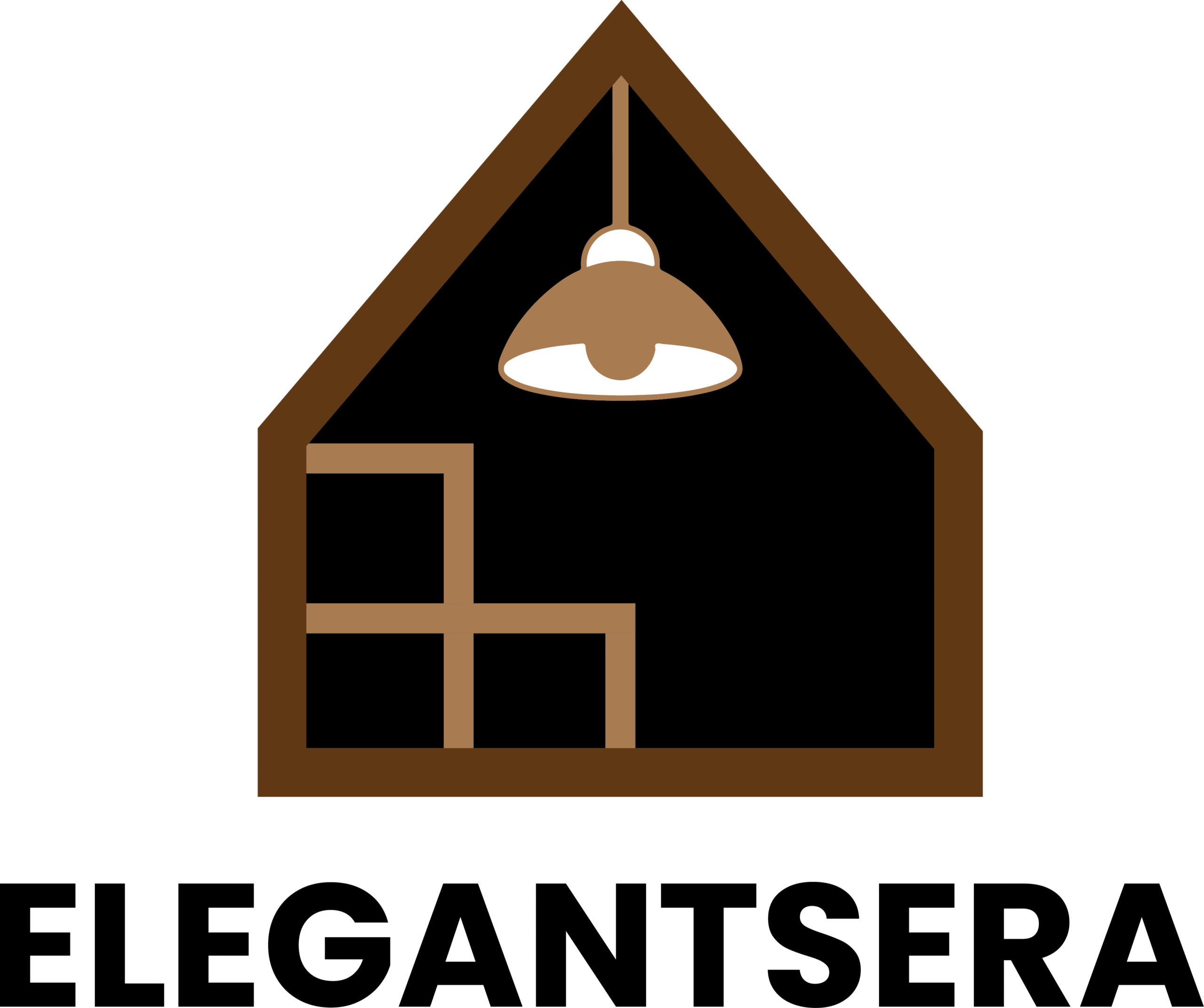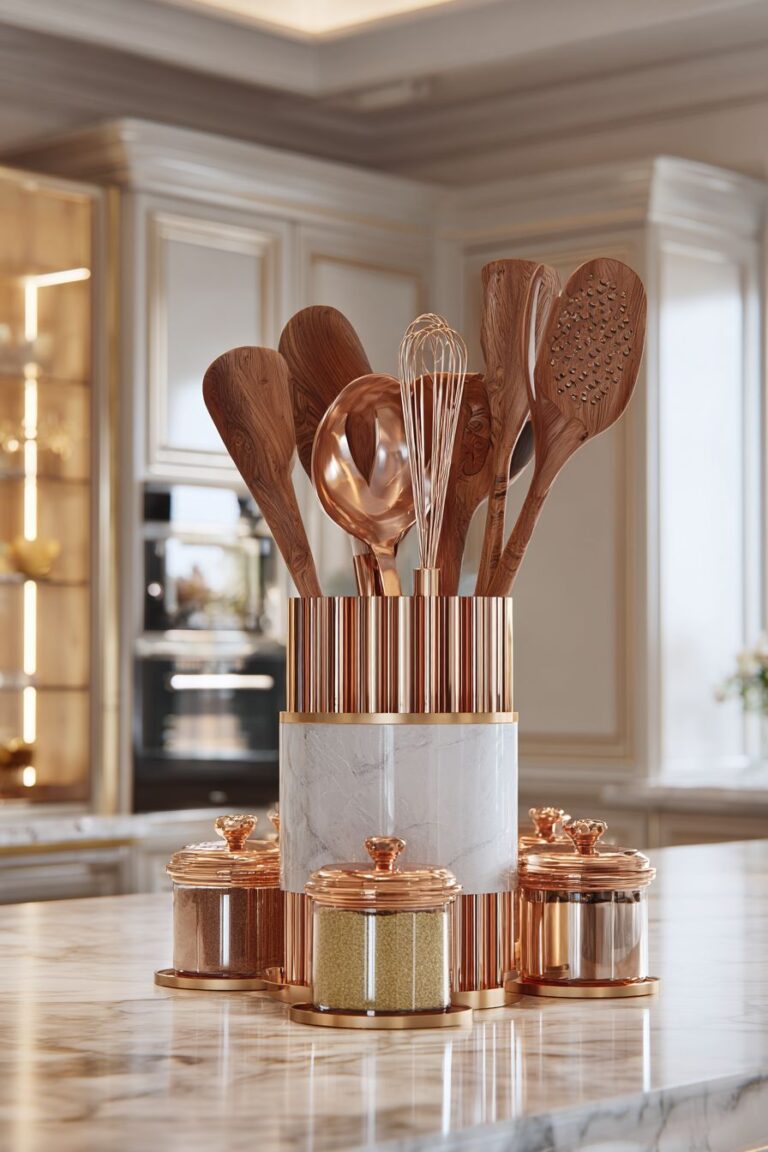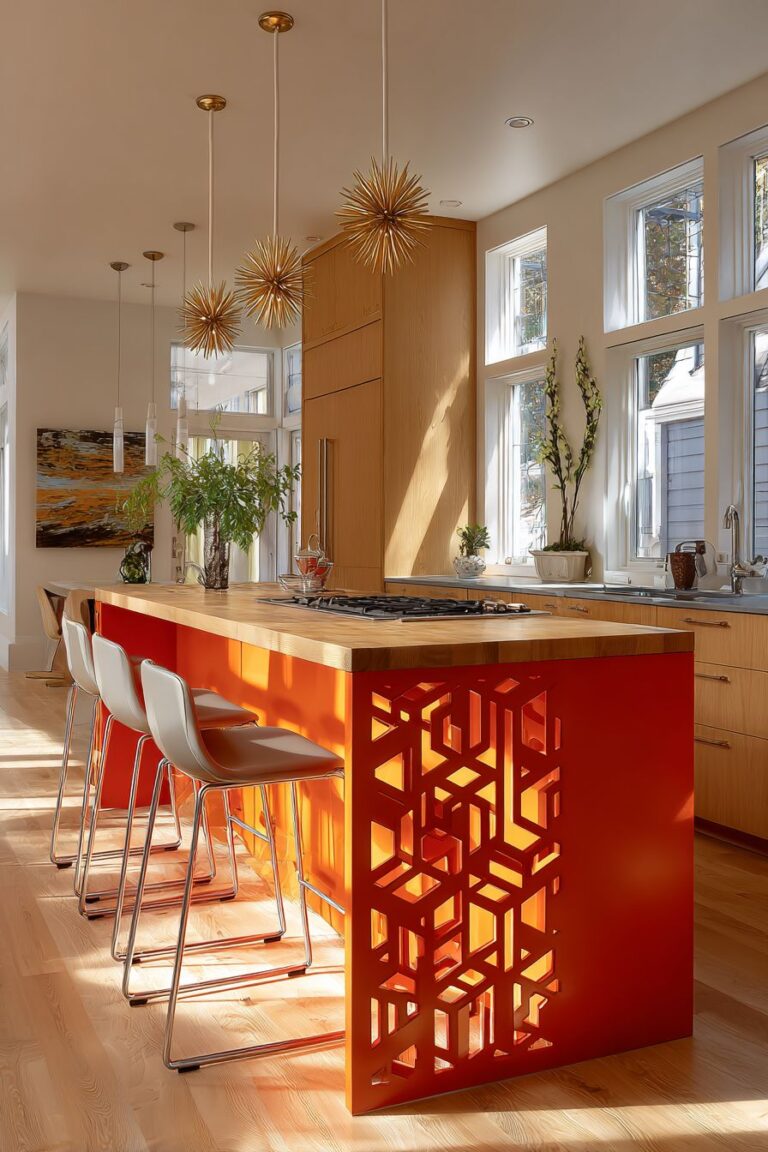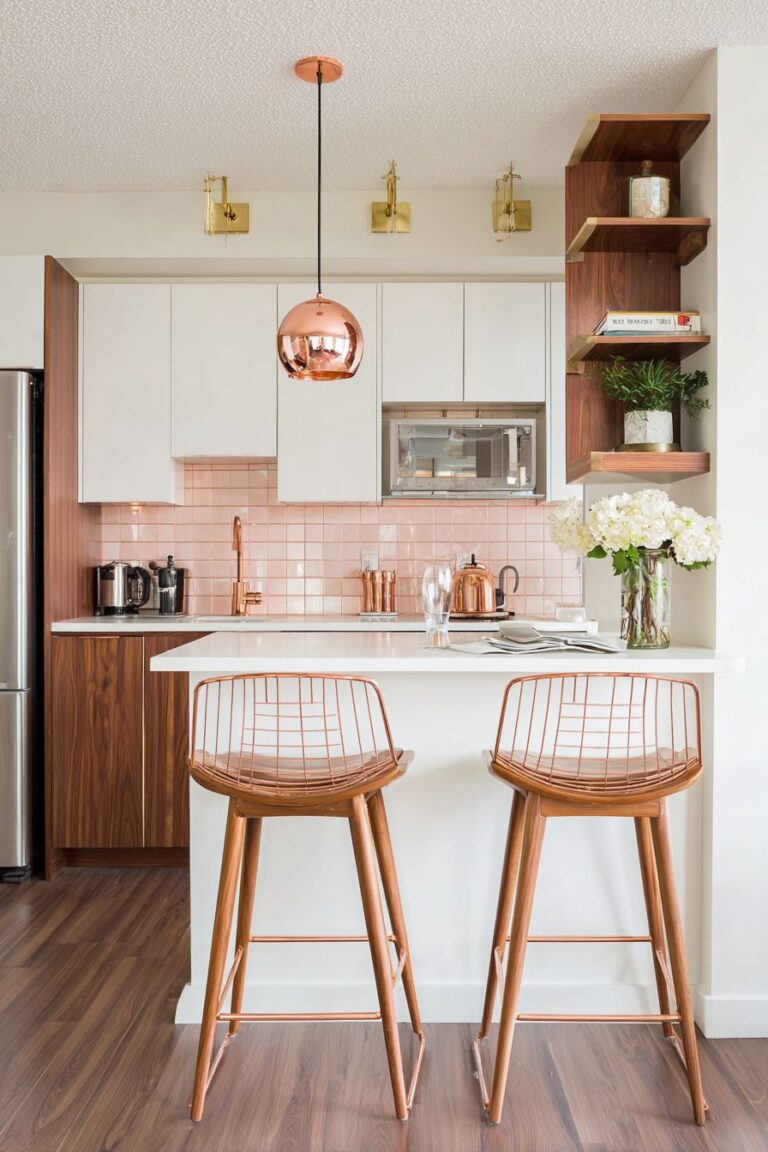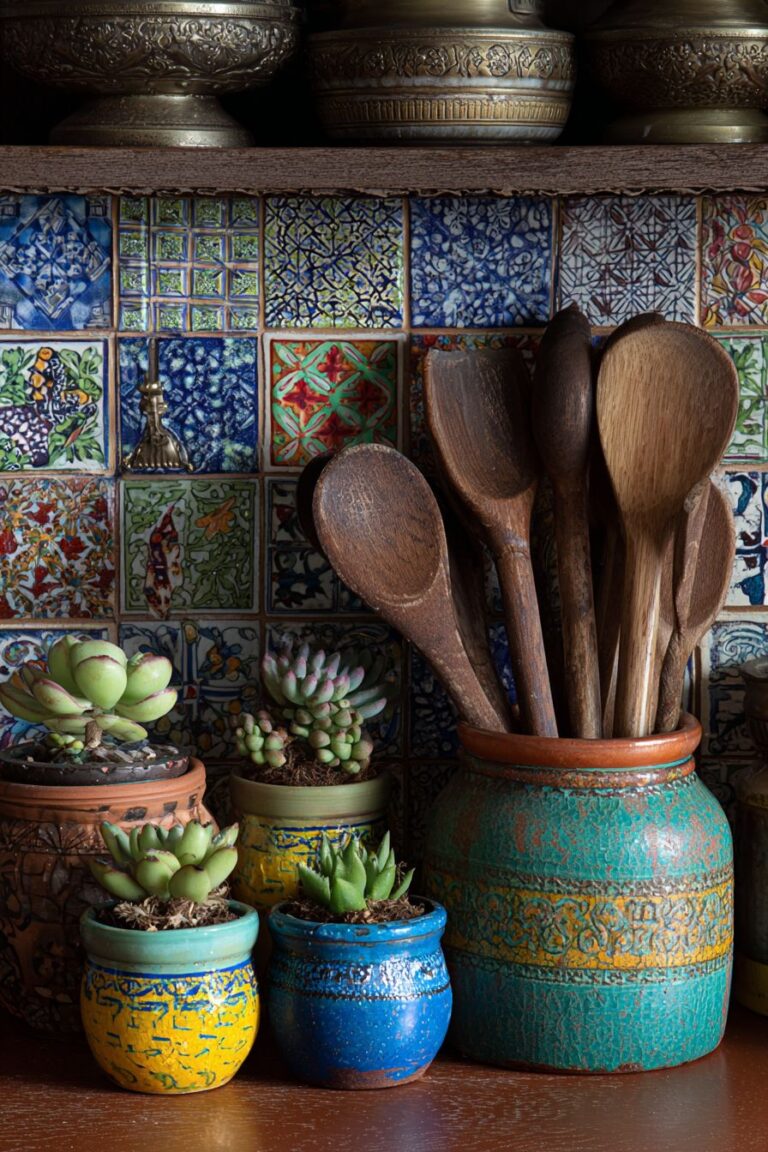20 Chimney Kitchen Ideas: From Modern to Rustic Design
The kitchen has evolved far beyond its traditional role as a simple cooking space to become the beating heart of modern homes. At the center of this transformation lies one of the most striking architectural elements: the chimney range hood. More than just a functional necessity, today’s chimney designs serve as dramatic focal points that define the entire aesthetic of your culinary sanctuary. Whether you’re drawn to sleek contemporary lines, rustic farmhouse charm, or industrial urban sophistication, the right chimney hood can elevate your kitchen from ordinary to extraordinary.
In today’s design landscape, homeowners are increasingly seeking ways to blend functionality with artistic expression. The chimney range hood represents the perfect marriage of these two essential elements, offering superior ventilation while making a bold design statement. From minimalist stainless steel compositions to ornate hand-carved wooden masterpieces, these architectural features have become the crown jewels of kitchen design. The beauty lies not only in their visual impact but also in their ability to tie together disparate design elements, creating cohesive spaces that reflect personal style and enhance daily living.
This comprehensive guide explores twenty distinct chimney kitchen concepts, each representing a unique approach to this essential design element. From the clean geometry of modern minimalism to the warm authenticity of Mediterranean stonework, these ideas showcase the incredible versatility and transformative power of thoughtfully designed chimney hoods. Each concept has been carefully selected to inspire and provide practical insights for creating your dream kitchen space.
1. Modern Minimalist Stainless Steel Elegance
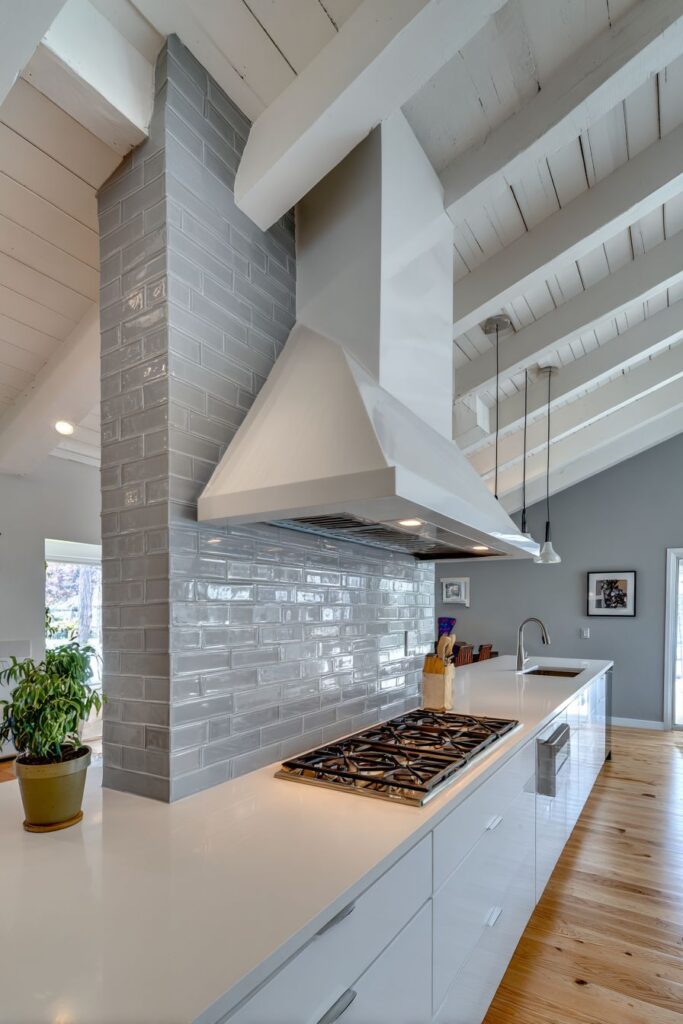
The epitome of contemporary kitchen design manifests in the sleek sophistication of a stainless steel wall-mounted chimney hood. This design approach embraces the philosophy that less is indeed more, creating a striking visual centerpiece through clean geometric lines and flawless metallic surfaces. The professional-grade stainless steel construction not only delivers superior performance but also introduces an element of commercial kitchen sophistication that elevates the entire space to restaurant-quality standards.
The surrounding design elements work in perfect harmony to support this minimalist vision. White quartz countertops provide a pristine canvas that reflects and amplifies natural light, while grey subway tiles extend from counter to ceiling, creating a seamless backdrop that allows the chimney hood to command attention. The strategic use of pendant lighting ensures that every surface catches and reflects light, emphasizing the precision engineering and flawless finish of the central feature.
What makes this design particularly compelling is its timeless appeal and practical longevity. Stainless steel surfaces resist stains, heat damage, and everyday wear, ensuring that your investment maintains its showroom appearance for years to come. The neutral color palette provides endless flexibility for seasonal updates through accessories, artwork, and textiles, while the clean lines ensure the design never appears dated or overly trendy.
The functional aspects of this design are equally impressive, with powerful ventilation systems hidden within the streamlined exterior. Modern technology allows for whisper-quiet operation, ensuring that the aesthetic beauty isn’t compromised by intrusive noise during cooking activities.
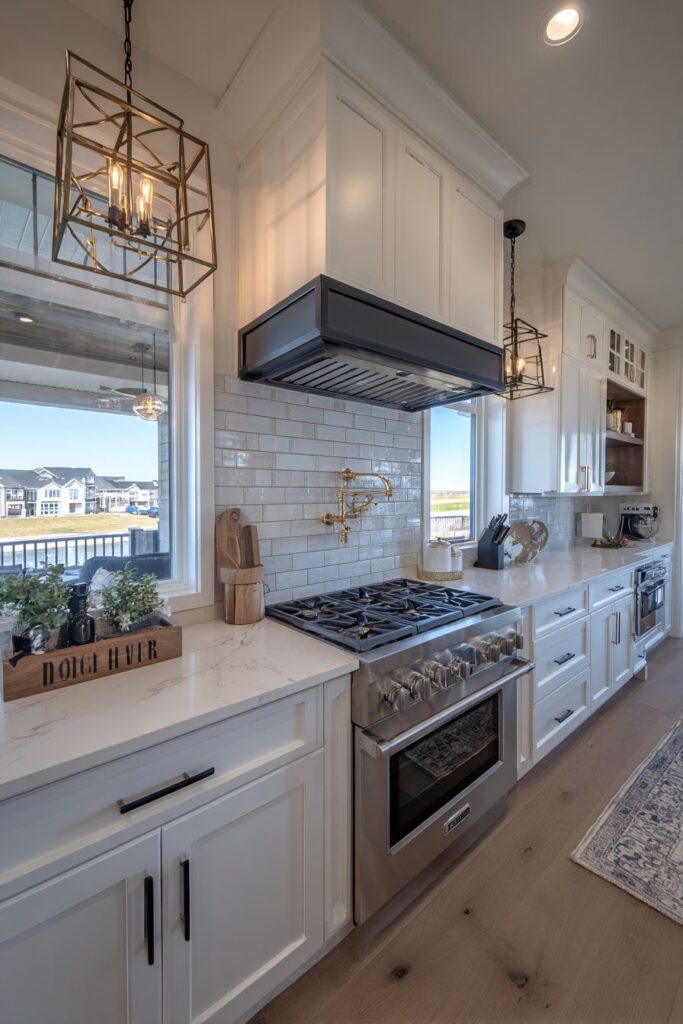
Key Design Tips:
- Choose brushed stainless steel finishes to minimize fingerprints and water spots
- Ensure proper proportion between hood size and cooktop for optimal visual balance
- Install LED strip lighting beneath the hood for enhanced task illumination
- Coordinate all stainless steel appliances for a cohesive professional appearance
- Use neutral colors throughout to let the metallic surfaces become the focal point
2. Rustic Copper Farmhouse Charm
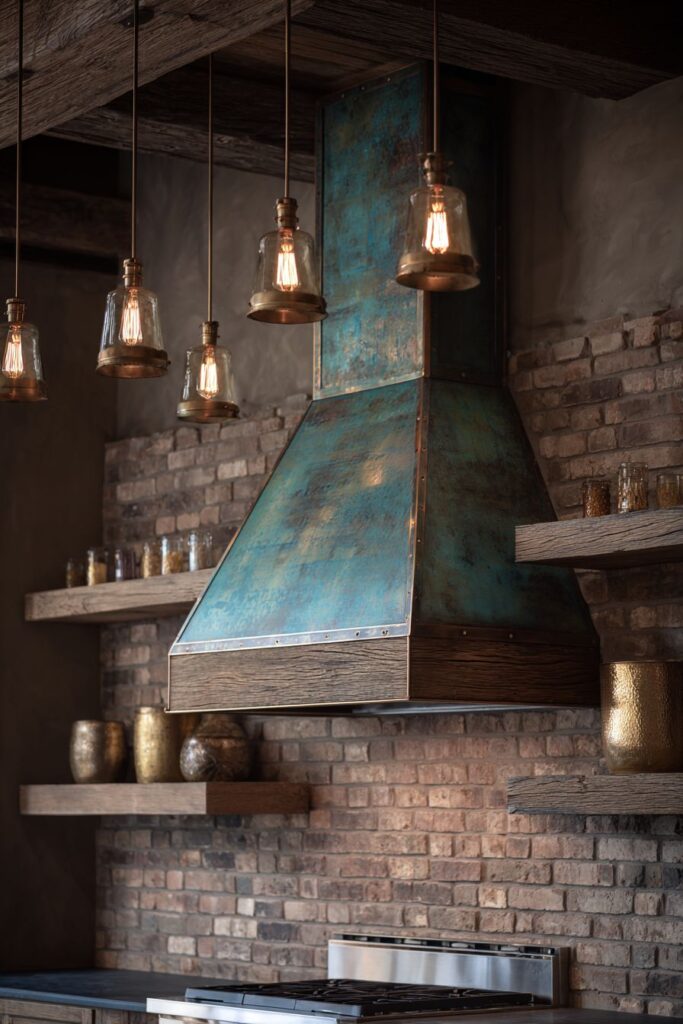
The warmth and character of aged copper transform a simple kitchen into a welcoming farmhouse sanctuary. This design concept celebrates the beauty of natural patination, where the copper surface develops unique color variations and character marks over time. The custom-crafted range hood serves as both functional equipment and artistic sculpture, demonstrating how traditional metalworking techniques can create contemporary design solutions with authentic historical roots.
Reclaimed wood shelving flanking the copper chimney adds layers of texture and provides practical storage solutions while reinforcing the rustic aesthetic. Each piece of weathered wood tells its own story, contributing to the overall narrative of sustainability and environmental consciousness. The exposed brick backsplash introduces yet another natural material, creating a rich tapestry of textures that invites touch and exploration.
The lighting design plays a crucial role in bringing this concept to life. Vintage Edison bulbs cast warm, golden light that enhances the copper’s natural glow and creates dramatic shadows that emphasize every handcrafted detail. This type of ambient lighting transforms meal preparation from a chore into a theatrical experience, where every cooking session becomes an opportunity to appreciate the artistry surrounding you.
The beauty of this design lies in its celebration of imperfection and natural aging. Unlike synthetic materials that degrade over time, copper develops increasing beauty and character, making your kitchen more valuable and visually interesting with each passing year.
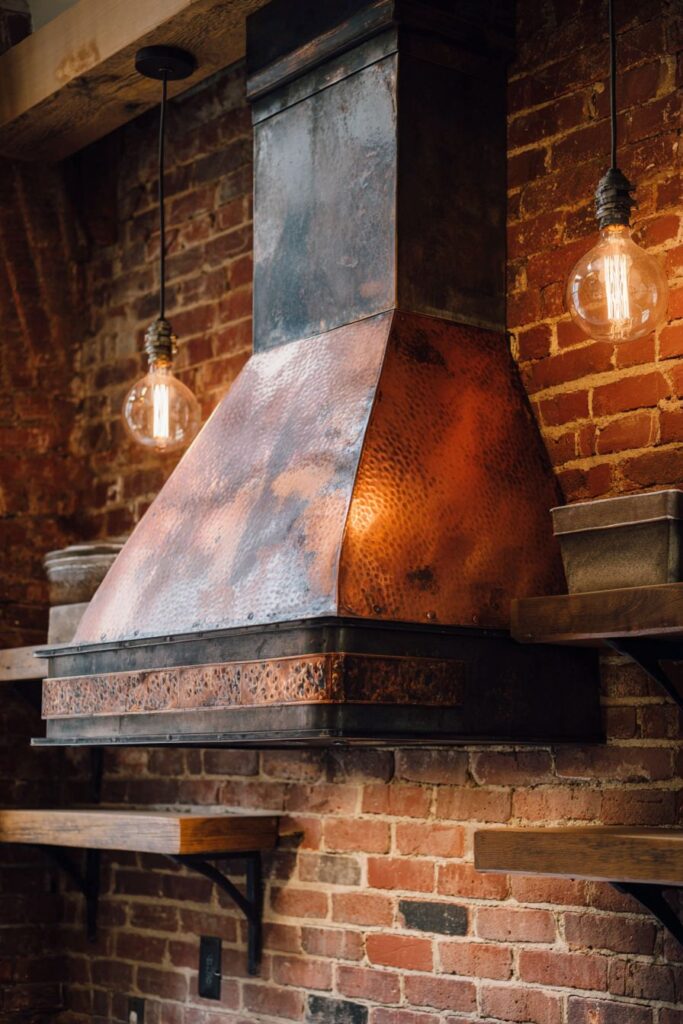
Key Design Tips:
- Allow copper to age naturally for authentic patina development
- Balance warm metals with cool stone or ceramic elements
- Incorporate Edison bulb fixtures for period-appropriate lighting
- Choose reclaimed materials to enhance the sustainable story
- Display vintage copper cookware as functional decoration
3. Industrial Strength Black Steel Power
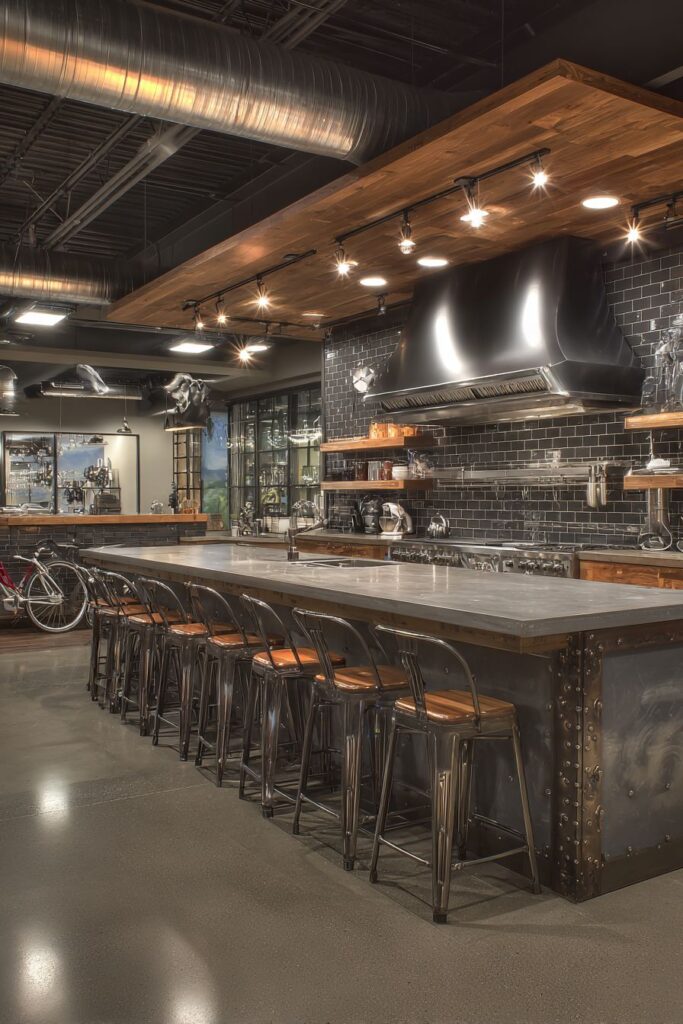
The raw power and utilitarian beauty of industrial design reach its pinnacle in this dramatic black steel chimney concept. This approach embraces the honest expression of materials and construction methods, creating a kitchen that feels like a converted urban loft or repurposed warehouse space. The exposed ductwork and riveted metal details aren’t hidden flaws to be concealed but celebrated architectural features that tell the story of function over form.
The large kitchen island beneath this commanding presence becomes a natural gathering point, while the concrete countertops provide durability that matches the industrial aesthetic. Charcoal grey subway tiles add subtle texture without competing with the bold metalwork above, creating a harmonious color palette that feels both sophisticated and approachable.
Track lighting systems provide the flexibility needed in working kitchens while maintaining the industrial theme through their utilitarian appearance. The wide-angle photography captures not just individual elements but the way light moves through the space, bouncing off metal surfaces and creating dynamic shadows that change throughout the day.
This design philosophy extends beyond mere aesthetics to embrace a lifestyle that values authenticity, durability, and honest materials. Every element is chosen for its ability to withstand heavy use while maintaining its character, making this an ideal choice for serious home cooks who demand both performance and style.

Key Design Tips:
- Embrace exposed mechanical elements as design features
- Choose materials that improve with age and use
- Install flexible lighting systems for various cooking tasks
- Balance hard surfaces with strategic soft furnishings
- Incorporate vintage industrial accessories for authentic character
4. Traditional Wooden Elegance

The timeless appeal of traditional craftsmanship shines through in this ornate wooden range hood design that pays homage to classical architectural principles. The decorative corbels and raised panel details represent centuries of woodworking tradition, while the soft cream paint finish creates a sense of refined elegance that transcends temporary trends. This approach to chimney design treats the hood as fine furniture, worthy of the same attention to detail and quality materials found in custom cabinetry.
The cooking alcove becomes a dedicated shrine to culinary arts, framed by classic white subway tiles with dark grout lines that provide visual interest without overwhelming the space. This traditional grid pattern has remained popular for over a century because of its ability to complement virtually any design style while providing practical, easy-to-clean surfaces ideal for food preparation areas.
Natural window light filtering through nearby casement windows creates the perfect illumination for appreciating the hand-crafted details and elegant proportions of this traditional design. The interplay of light and shadow throughout the day reveals different aspects of the woodwork, from the subtle grain patterns in the wood to the precise joinery that speaks of master craftsman attention to detail.
Professional interior photography captures not just the visual elements but the sense of heritage and permanence that this type of traditional design brings to modern homes.

Key Design Tips:
- Select high-quality hardwoods that accept paint finishes well
- Ensure proper ventilation behind decorative wooden elements
- Match the hood’s proportions to existing cabinetry for harmony
- Use traditional joinery techniques for authentic appearance
- Consider crown molding to integrate the hood with ceiling architecture
5. Contemporary Concrete Artistry
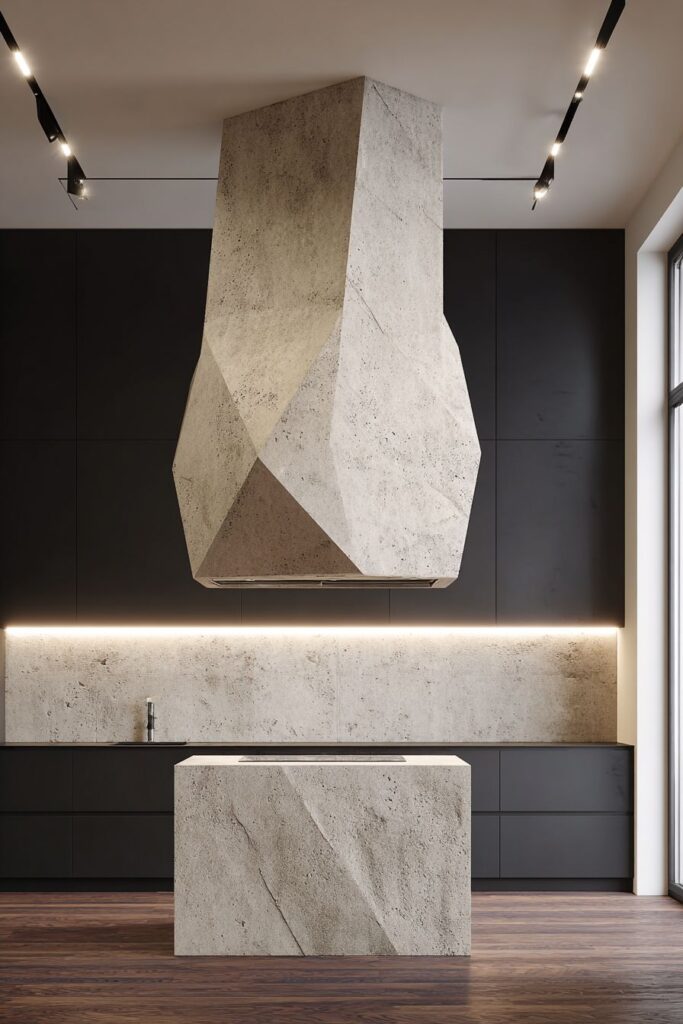
The sculptural possibilities of concrete reach new heights in this geometric range hood that challenges conventional thinking about kitchen design. Clean angular lines and seamless integration demonstrate how industrial materials can be refined into sophisticated architectural elements worthy of modern art galleries. The textured concrete surface provides visual and tactile interest while maintaining the monochromatic color palette essential to minimalist design principles.
Handleless cabinets in matte black create a striking contrast that emphasizes the concrete’s natural color variations and surface texture. This juxtaposition of materials – smooth painted surfaces against rough textured concrete – creates visual tension that keeps the space interesting while maintaining overall design coherence. The absence of hardware maintains clean lines while advanced soft-close mechanisms ensure practical functionality.
LED strip lighting positioned beneath the hood provides essential task illumination while highlighting the concrete’s unique surface characteristics. The quality of light can dramatically change the appearance of textured surfaces, revealing subtle patterns and color variations that aren’t visible under standard overhead lighting conditions.
Architectural photography techniques capture the sculptural quality of this custom design, emphasizing how kitchen elements can transcend their purely functional roles to become artistic statements that define entire living spaces.
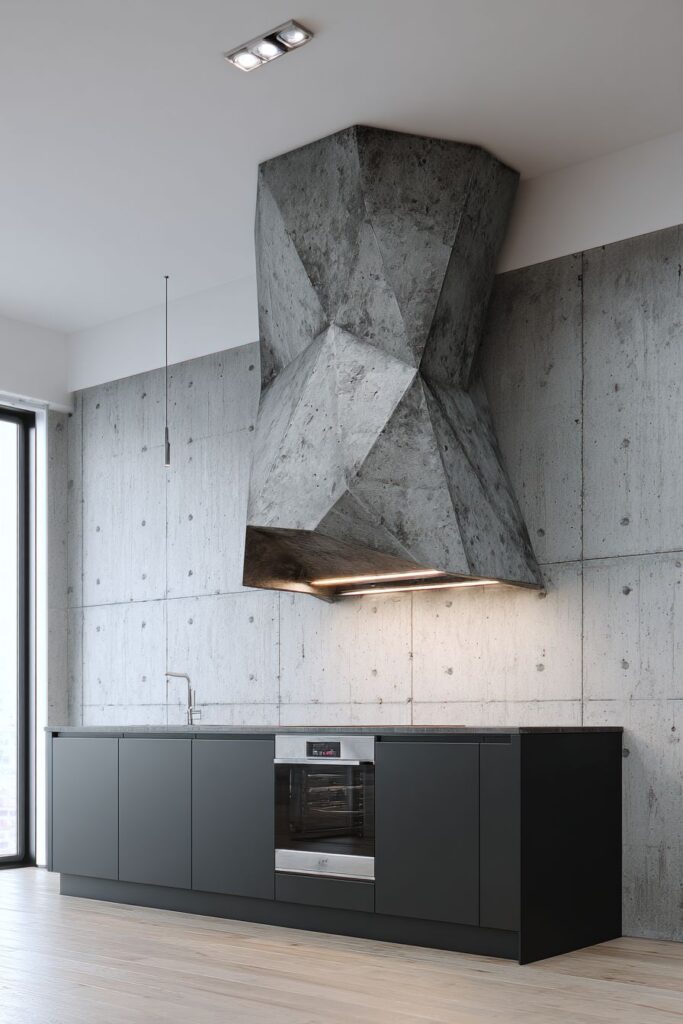
Key Design Tips:
- Work with experienced concrete artisans for professional finishing
- Plan electrical integration during the concrete forming process
- Use contrasting materials to highlight concrete’s unique texture
- Install proper ventilation to manage concrete’s thermal mass
- Consider sealers appropriate for food preparation environments
6. Mediterranean Stone and Stucco Romance
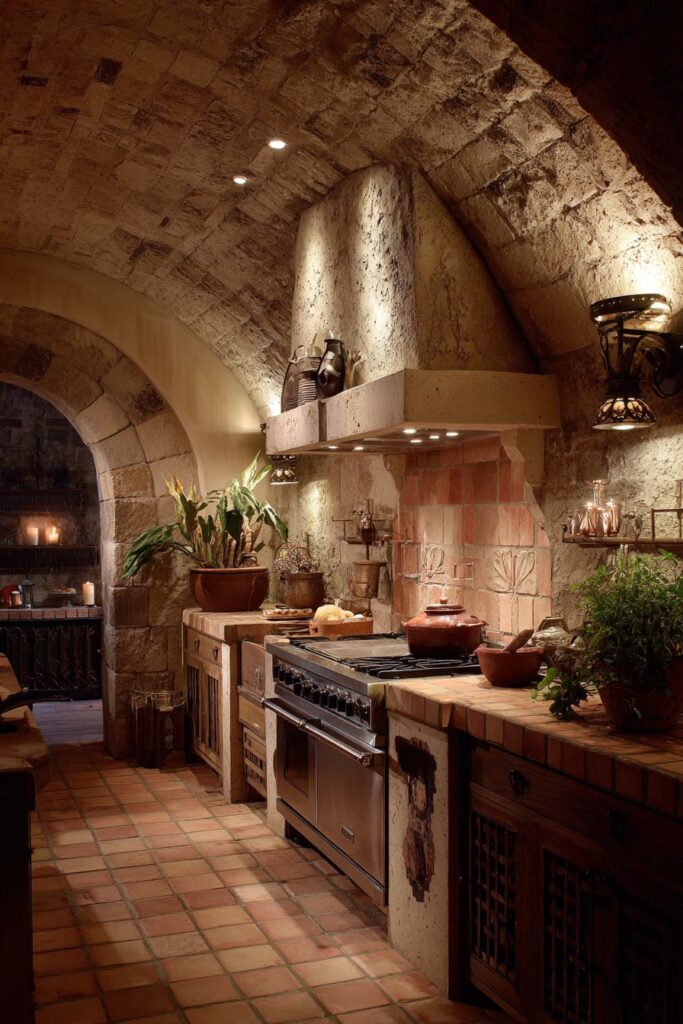
The sun-soaked warmth of Mediterranean design comes alive through this rustic stone and stucco range hood that evokes centuries-old European cooking traditions. The arched opening reminiscent of ancient hearths creates an immediate connection to Old World craftsmanship, while the combination of natural stone and hand-applied stucco provides authentic texture that modern manufactured materials simply cannot replicate.
Terra cotta tile backsplashes introduce the earthy colors and rustic charm essential to Mediterranean aesthetics. These handmade tiles, with their subtle color variations and irregular surfaces, tell the story of traditional craftsmanship passed down through generations. Wrought iron details add another layer of authenticity, from decorative brackets to hardware that shows the marks of the blacksmith’s hammer.
Warm ambient lighting from hand-forged wrought iron fixtures creates the inviting shadows and golden atmosphere that makes Mediterranean kitchens feel like extensions of outdoor living spaces. The quality of light in these spaces changes throughout the day, from cool morning clarity to warm evening glow, creating an ever-changing backdrop for family meals and entertaining.
Interior design photography captures not just individual elements but the way they work together to create an integrated environment that feels transported from a Tuscan villa or Spanish farmhouse.
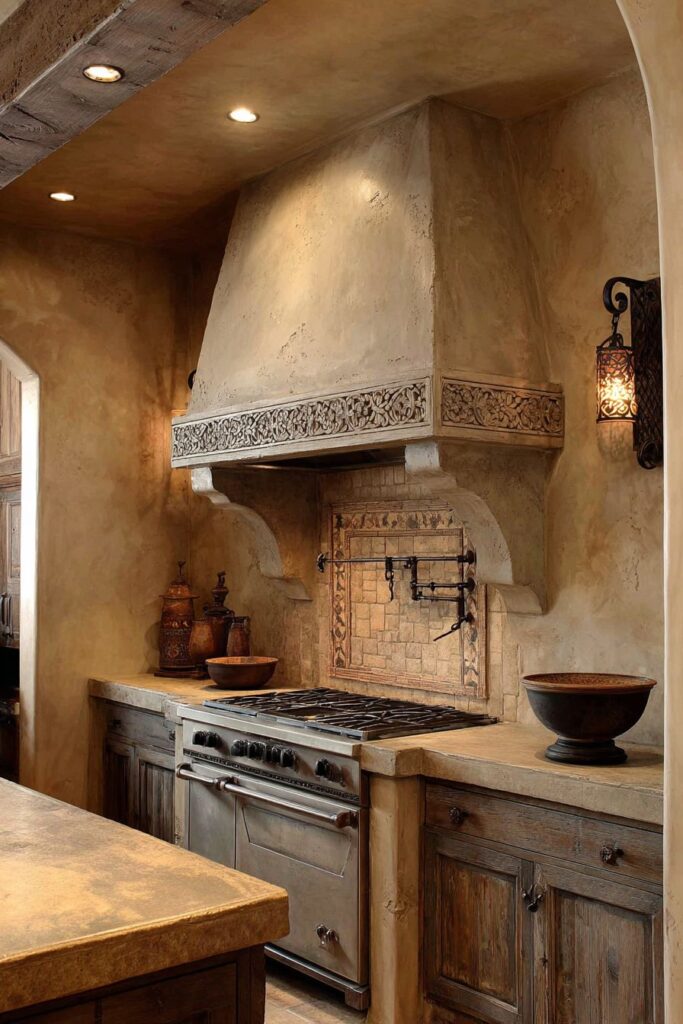
Key Design Tips:
- Source authentic materials from traditional suppliers when possible
- Allow for natural variation in handmade tile patterns
- Install dimmable lighting systems for flexible ambiance control
- Incorporate live plants to enhance the outdoor connection
- Choose warm, earthy colors throughout the space
7. Scandinavian Light Oak Simplicity
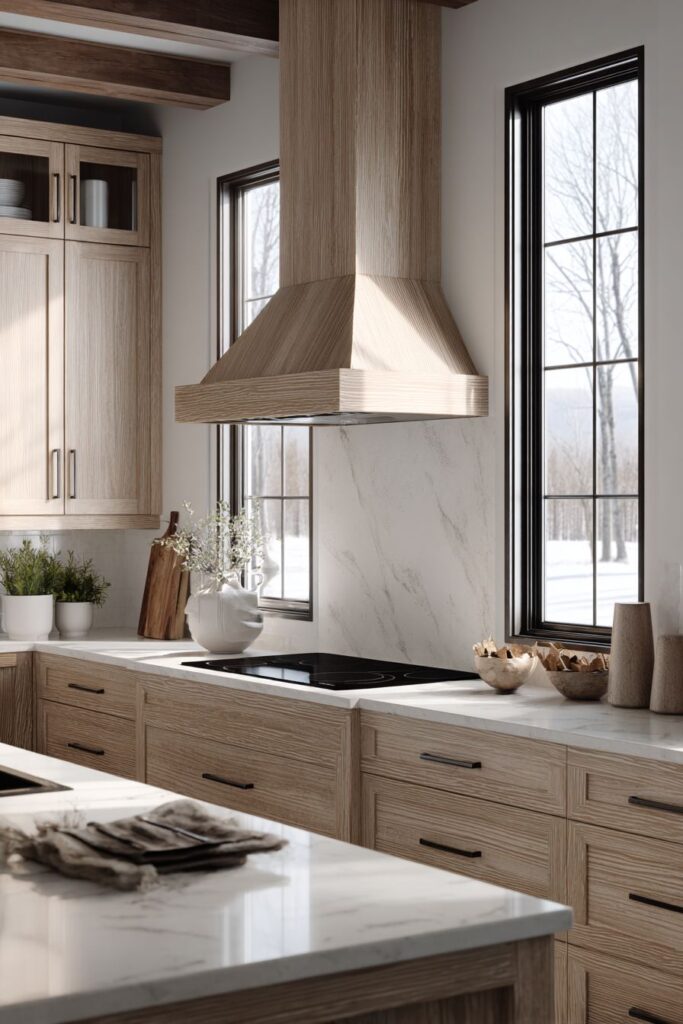
The essence of Nordic design philosophy permeates this light oak wood range hood that celebrates natural materials and clean, functional lines. The natural wood finish showcases the beautiful grain patterns that make each piece unique, while the minimalist design approach ensures that these natural characteristics remain the focal point rather than being overshadowed by ornate details.
Blonde wood cabinets and white marble countertops create a harmonious palette that reflects the Scandinavian love of light, natural materials, and uncluttered spaces. This combination of warm wood tones and cool stone creates perfect balance – neither too sterile nor too rustic, but achieving that coveted hygge atmosphere that makes spaces feel both sophisticated and comfortable.
Soft natural lighting from north-facing windows provides the ideal illumination for appreciating the organic wood grain and subtle color variations that make solid wood so appealing. This type of consistent, even lighting is prized in Scandinavian countries where winter days are short and maximizing natural light becomes essential for comfortable living.
Professional photography techniques highlight how the minimalist aesthetic doesn’t mean boring – instead, it allows the inherent beauty of high-quality materials to shine without competition from unnecessary decoration or visual clutter.
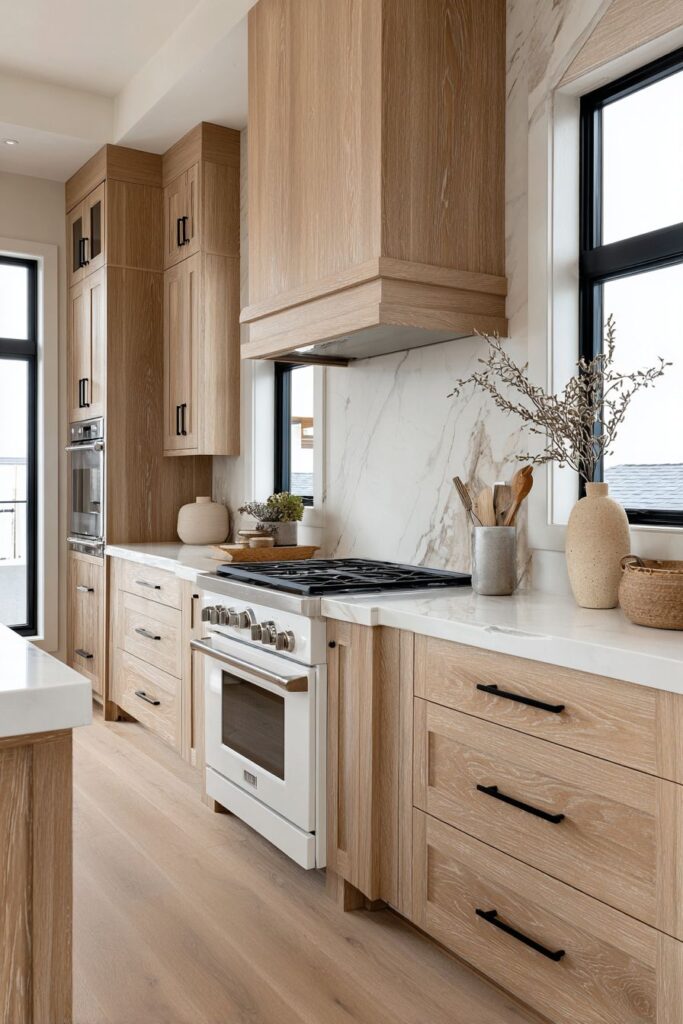
Key Design Tips:
- Choose sustainably harvested woods with FSC certification
- Apply natural oil finishes that allow wood to breathe and age gracefully
- Maximize natural light through window treatments and light colors
- Incorporate hygge elements like natural textiles and candlelight
- Maintain clutter-free surfaces to preserve the minimalist aesthetic
8. Farmhouse Shiplap Character
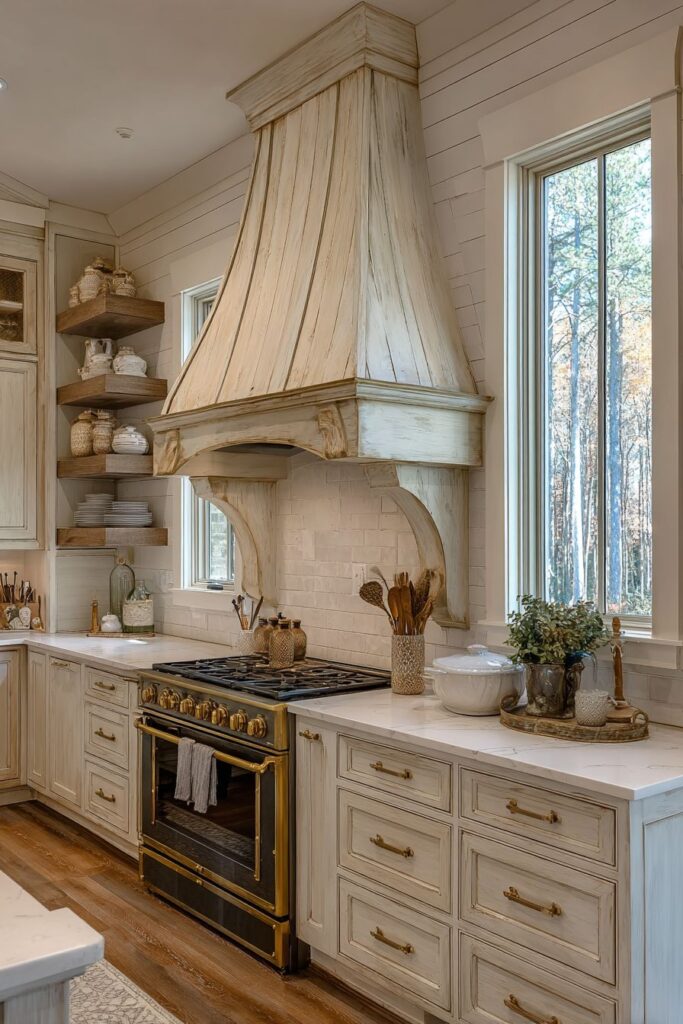
The cozy, lived-in charm of authentic farmhouse design comes through beautifully in this distressed white wooden range hood featuring classic shiplap details and decorative brackets. This design approach embraces the imperfections and wear patterns that develop over time, celebrating them as marks of character rather than flaws to be hidden. The vintage-style gas range below completes the period-appropriate ensemble.
Open shelving provides both practical storage and display opportunities for ceramic dishware that becomes part of the overall design scheme. These carefully curated collections of dishes, bowls, and serving pieces add personality and warmth while demonstrating how functional elements can contribute to aesthetic appeal when thoughtfully arranged.
Subway tile extending to the ceiling creates a classic backdrop that has remained popular for over a century because of its timeless appeal and practical benefits. The white tile reflects light effectively, making the space feel larger and brighter while providing easy-to-clean surfaces essential in working kitchens.
Golden hour natural lighting streaming through nearby windows creates the perfect ambiance for appreciating the handcrafted details and casual elegance that define authentic farmhouse style.
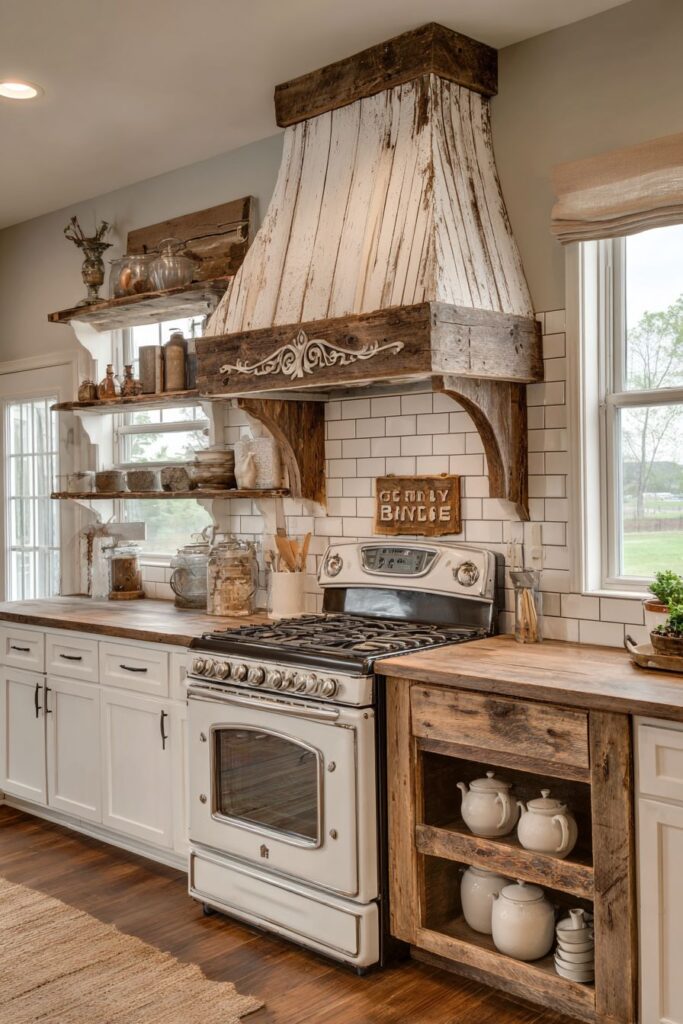
Key Design Tips:
- Embrace natural aging and distressing rather than artificial techniques
- Display everyday dishes as decorative elements
- Use subway tile as a neutral backdrop for other design elements
- Install period-appropriate hardware throughout the space
- Incorporate vintage accessories and found objects with history
9. Modern Transitional Two-Tone Sophistication

The sophisticated blend of traditional and contemporary elements reaches perfect expression in this two-tone range hood that combines a white painted wood base with a stainless steel ventilation crown. This approach demonstrates how seemingly contradictory design elements can work together when unified by thoughtful proportions and quality materials. The result feels both timeless and current, avoiding the extremes of either purely traditional or ultra-modern approaches.
The kitchen island’s marble waterfall countertops provide a dramatic focal point that complements the hood’s sophisticated material combination. Navy blue cabinetry adds depth and richness to the color palette while maintaining the professional appearance essential to serious cooking spaces. These deeper colors provide excellent contrast for displaying colorful ingredients and finished dishes.
Recessed lighting systems provide even, shadow-free illumination that’s essential for food preparation while maintaining the clean ceiling lines important to contemporary design. Professional interior photography captures the balanced exposure throughout the space, demonstrating how proper lighting design can make every surface appear at its best.
This transitional approach appeals to homeowners who appreciate both classical elegance and modern convenience, creating spaces that feel rooted in tradition while embracing contemporary lifestyle needs.

Key Design Tips:
- Balance warm and cool materials for visual interest
- Choose proportions that complement existing architectural elements
- Install layered lighting systems for maximum flexibility
- Select hardware that bridges traditional and contemporary styles
- Use classic colors in modern applications for timeless appeal
10. Art Deco Glamorous Luxury
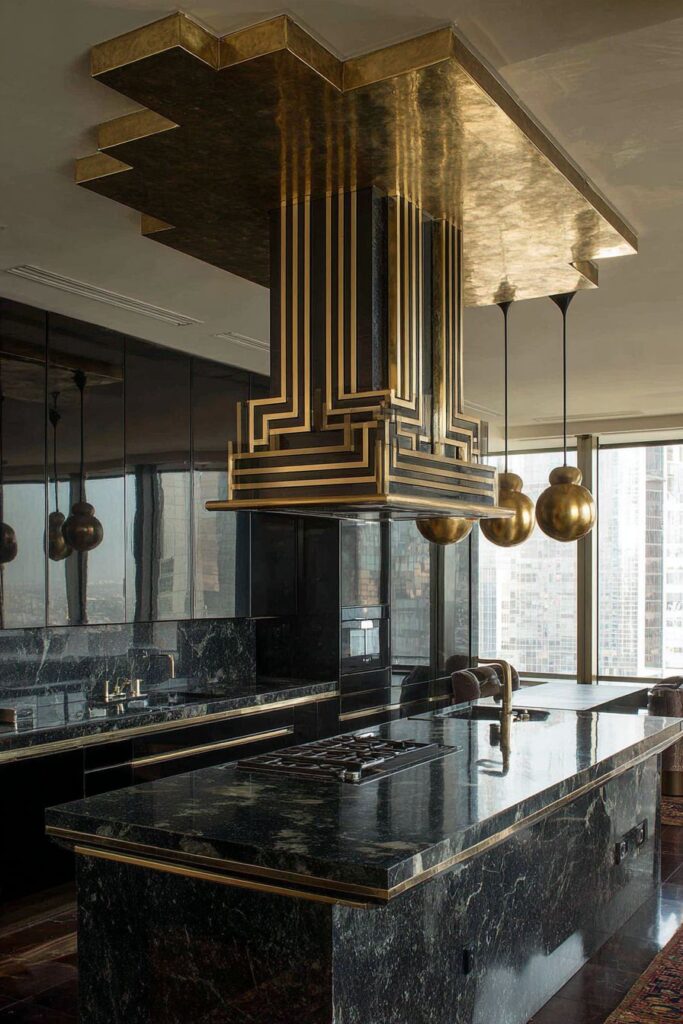
The sophisticated glamour of the Art Deco era comes alive through this striking black and gold range hood featuring geometric stepped details and brass accent strips. This design approach celebrates luxury materials and bold patterns that were hallmarks of 1920s design, updated with modern functionality and construction techniques. The high-gloss black cabinets and dramatic white marble veining complete this opulent aesthetic.
The geometric patterns characteristic of Art Deco design create visual rhythm and movement that draws the eye upward, making the ceiling appear higher while adding architectural interest to what might otherwise be a simple rectangular hood. The brass accents catch and reflect light, creating sparkle and warmth that prevents the black surfaces from feeling too somber or heavy.
Warm brass pendant lighting fixtures continue the metallic theme while providing focused task lighting for food preparation. The quality and direction of this light is crucial for bringing out the best in metallic finishes, creating the elegant reflections and subtle highlights that make luxury materials appear truly luxurious.
Architectural photography emphasizes the bold geometric patterns and rich material palette that defines this glamorous approach to kitchen design, capturing both the dramatic visual impact and refined details.
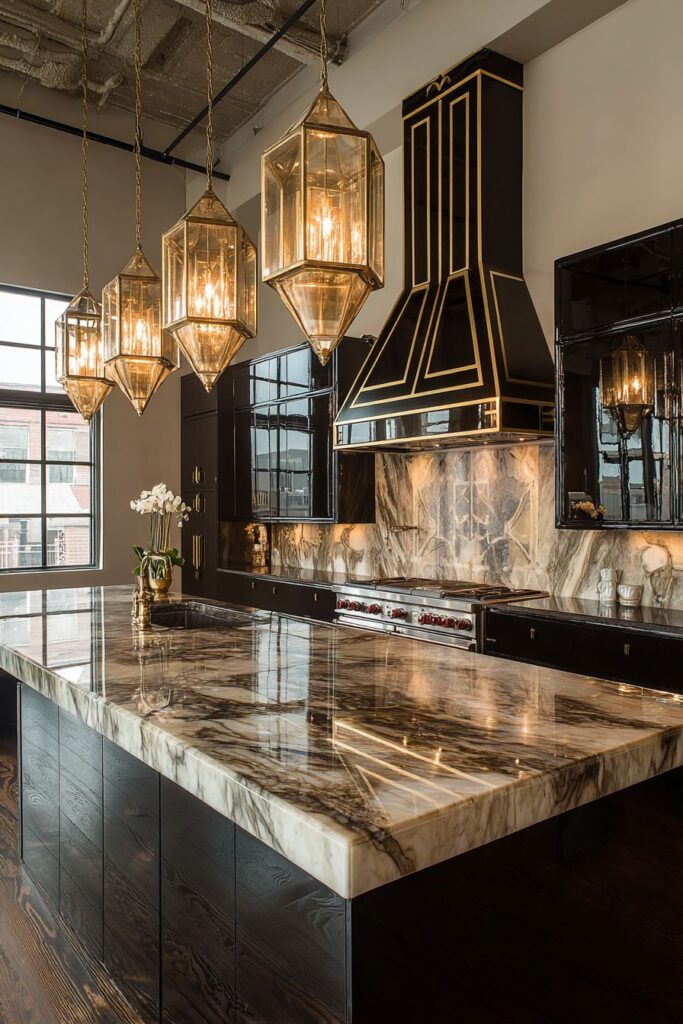
Key Design Tips:
- Polish brass regularly to maintain its golden luster
- Use geometric patterns consistently throughout the design
- Choose high-gloss finishes that reflect light dramatically
- Install appropriate lighting to enhance metallic surfaces
- Balance bold patterns with solid color fields for visual rest
11. Coastal Weathered Driftwood Serenity
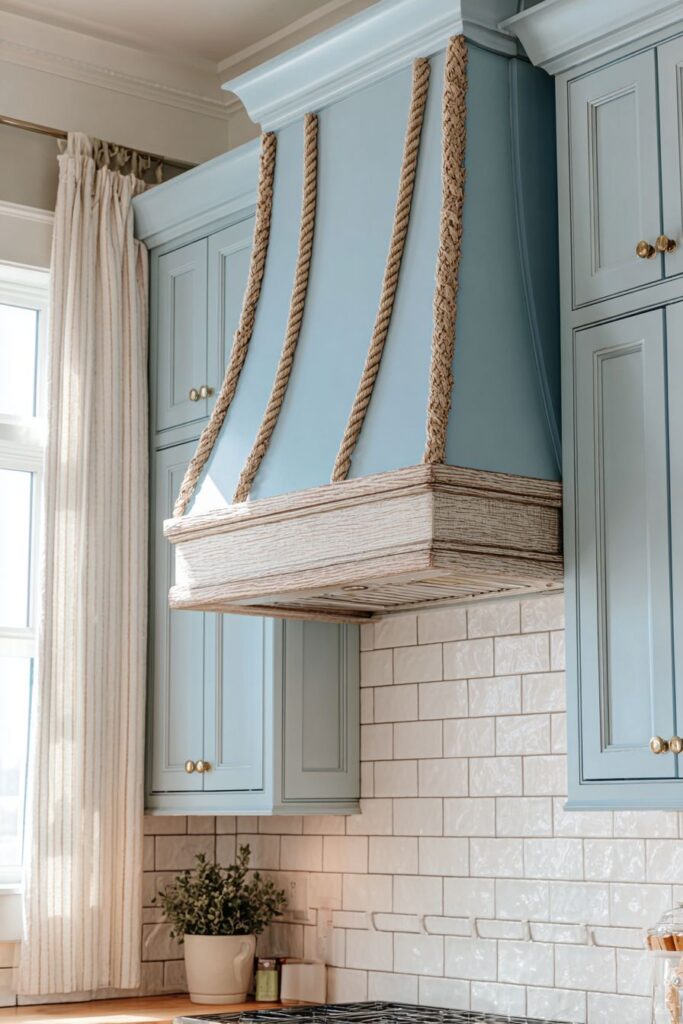
The relaxed elegance of coastal living finds perfect expression in this weathered driftwood range hood adorned with authentic rope details and nautical hardware. This design approach captures the casual sophistication of beachside living, where natural materials weather gracefully and imperfections become part of the charm. The white subway tile backsplash provides a clean, ship-like backdrop that enhances the maritime theme.
Light blue painted cabinets evoke the colors of sky and sea, while butcher block countertops add warmth and practicality that’s essential in casual family kitchens. These natural wood surfaces develop character over time, accepting the nicks and stains that come with daily use as badges of a life well-lived rather than damage to be regretted.
Natural lighting filtering through sheer curtains creates the soft, diffused illumination characteristic of seaside environments. This gentle light quality prevents harsh shadows while maintaining the bright, airy feeling essential to coastal design aesthetics. The transparency of sheer fabrics maintains privacy while preserving views and light flow.
Interior design photography captures the relaxed, seaside-inspired materials and casual elegance that make coastal kitchens feel like permanent vacation retreats.
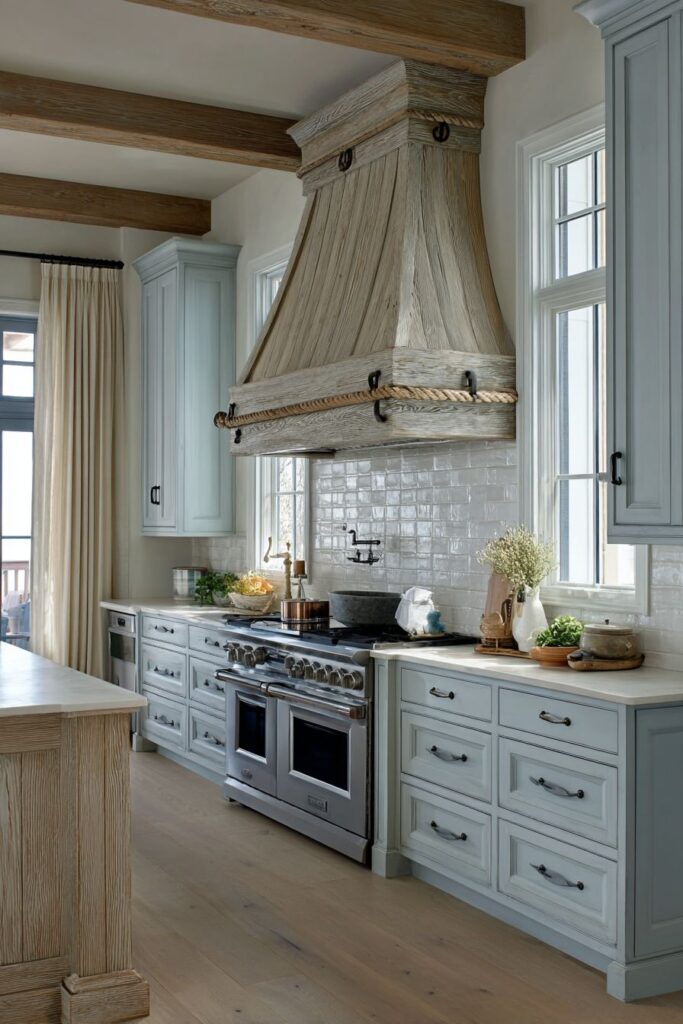
Key Design Tips:
- Source authentic driftwood from sustainable suppliers
- Choose marine-grade hardware that resists salt air corrosion
- Use natural fibers for window treatments and accessories
- Incorporate shells and sea glass as decorative accents
- Select easy-care materials that embrace a lived-in appearance
12. Mid-Century Modern Walnut Sophistication
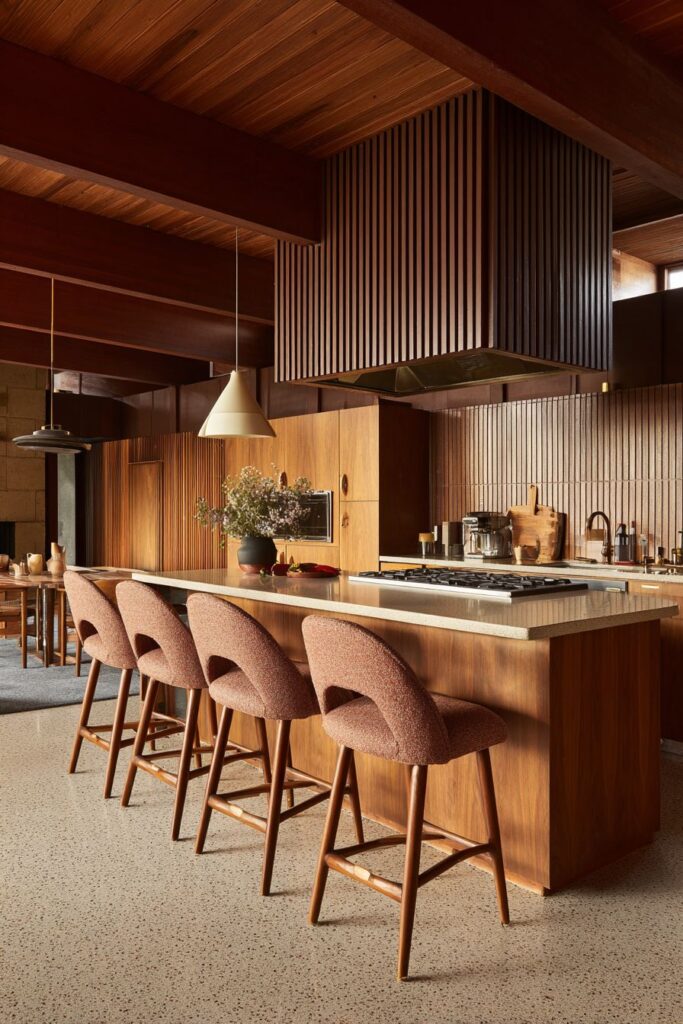
The iconic design language of the 1960s reaches full expression in this walnut wood range hood featuring horizontal slat design and brass ventilation grille. This period-appropriate approach celebrates the rich wood tones and geometric patterns that defined mid-century modernism, while brass details add the metallic accents that were essential to the era’s sophisticated palette.
Teak cabinets and terrazzo countertops maintain the authentic aesthetic that serious mid-century enthusiasts demand. These materials weren’t chosen arbitrarily but represented the pinnacle of modern material science and manufacturing techniques available during the atomic age. The combination creates visual and tactile richness while maintaining the clean lines essential to modernist principles.
Geometric pendant lighting provides focused illumination while continuing the angular themes that characterize this design approach. The fixtures themselves become sculptural elements that contribute to the overall aesthetic rather than merely providing functional lighting. Period-appropriate appliances complete the authentic atmosphere.
Professional photography techniques highlight the iconic furniture forms and rich wood tones that make mid-century modern design perpetually popular, demonstrating how quality materials and thoughtful proportions create timeless appeal.
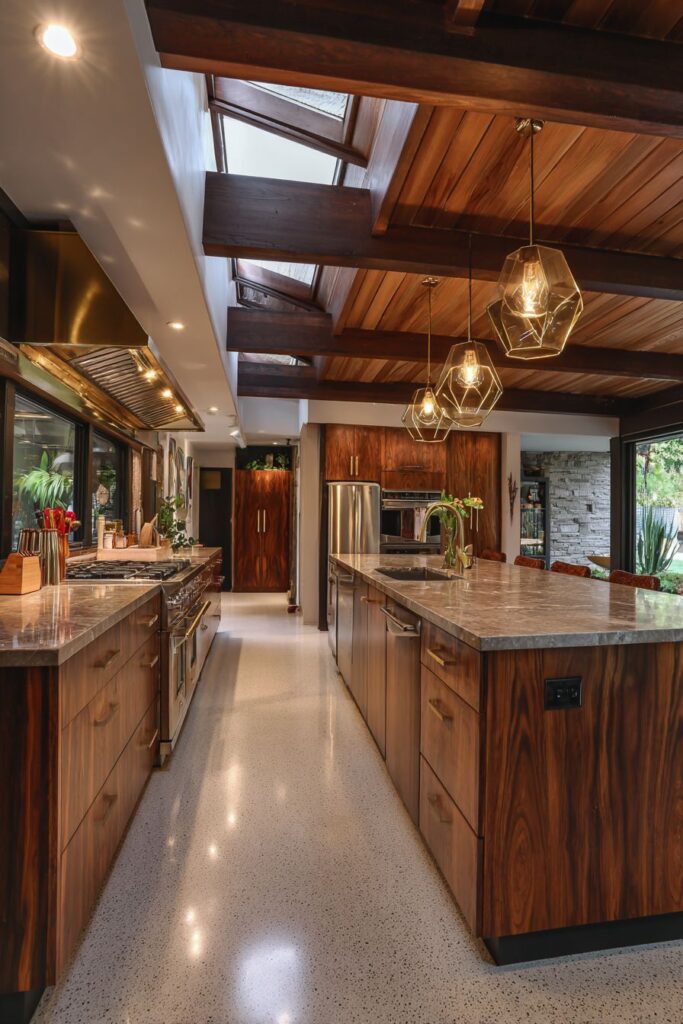
Key Design Tips:
- Source period-appropriate materials when possible
- Maintain authentic proportions and geometric relationships
- Choose furniture and accessories from the same era
- Use brass and warm metals rather than chrome or stainless steel
- Incorporate atomic-age patterns and angular designs consistently
13. French Country Provincial Romance
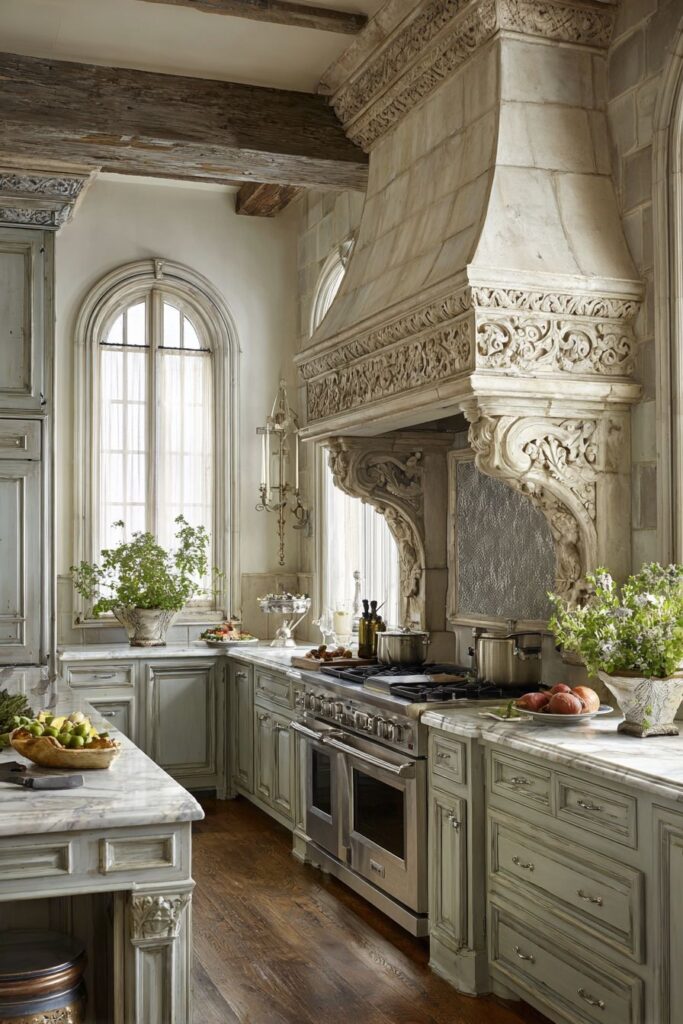
The romantic charm of French provincial design comes alive through this ornate limestone range hood featuring carved corbels and decorative moldings that speak of Old World craftsmanship and attention to detail. The hand-carved stonework represents centuries of tradition, where master craftsmen created functional elements that were also works of art worthy of the finest châteaux.
Distressed painted cabinets in sage green provide the perfect complement to the limestone’s natural color, while Carrara marble countertops add elegance and practicality. These materials work together to create the layered, collected-over-time appearance that is essential to authentic French country style. The weathering and patination of painted surfaces tells the story of generations of family meals and celebrations.
Soft natural lighting from traditional casement windows illuminates the handcrafted stonework while creating the gentle, romantic atmosphere characteristic of French interior design. The quality of this light changes throughout the day, from cool morning clarity to warm afternoon gold, creating an ever-changing backdrop that keeps the space visually interesting.
Wide-angle photography captures the romantic Old World charm that makes French country kitchens feel like they’ve been transported from a Loire Valley manor house.
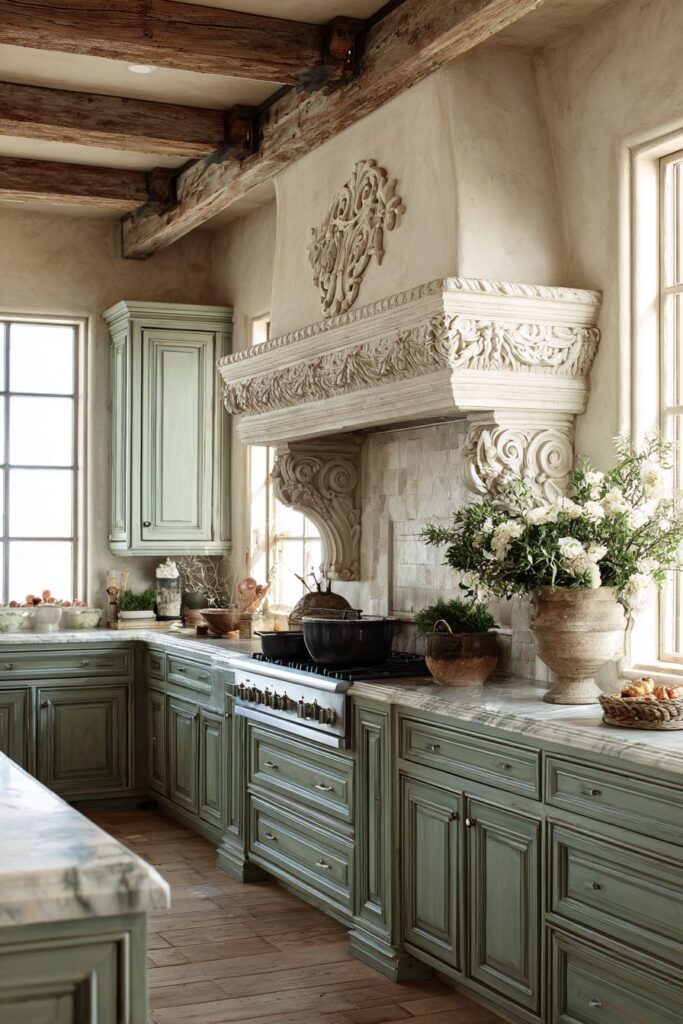
Key Design Tips:
- Invest in quality stone carving from skilled artisans
- Choose paint finishes that accept distressing naturally
- Install authentic French hardware and fixtures
- Use natural materials throughout for consistency
- Incorporate fresh herbs and flowers as living decoration
14. Contemporary Floating Steel Innovation

The cutting-edge innovation of contemporary design reaches new heights in this floating stainless steel range hood that appears to defy gravity through its invisible mounting system. This sculptural focal point demonstrates how advanced engineering can create seemingly impossible visual effects while maintaining full functionality. The seamless integration with the surrounding minimalist aesthetic creates harmony between form and function.
White lacquer cabinets and polished concrete floors maintain the monochromatic palette essential to minimalist design, while their contrasting textures provide visual and tactile interest. The high-gloss surfaces reflect light dramatically, making the space feel larger and more dynamic while the concrete floors ground the design with their substantial presence.
LED perimeter lighting emphasizes the hood’s clean geometry while providing the even, shadow-free illumination essential for food preparation. The quality of LED light can be precisely controlled for color temperature and intensity, allowing the homeowner to adjust the ambiance throughout the day while maintaining optimal working conditions.
Architectural photography showcases the seamless integration of form and function that defines the best contemporary design, capturing both the visual drama and practical sophistication.

Key Design Tips:
- Work with structural engineers for proper invisible mounting
- Choose LED systems with dimming and color temperature control
- Maintain consistent material palette throughout the space
- Install proper ventilation despite the floating appearance
- Use reflective surfaces to enhance the sculptural qualities
15. Rustic Modern Live-Edge Character
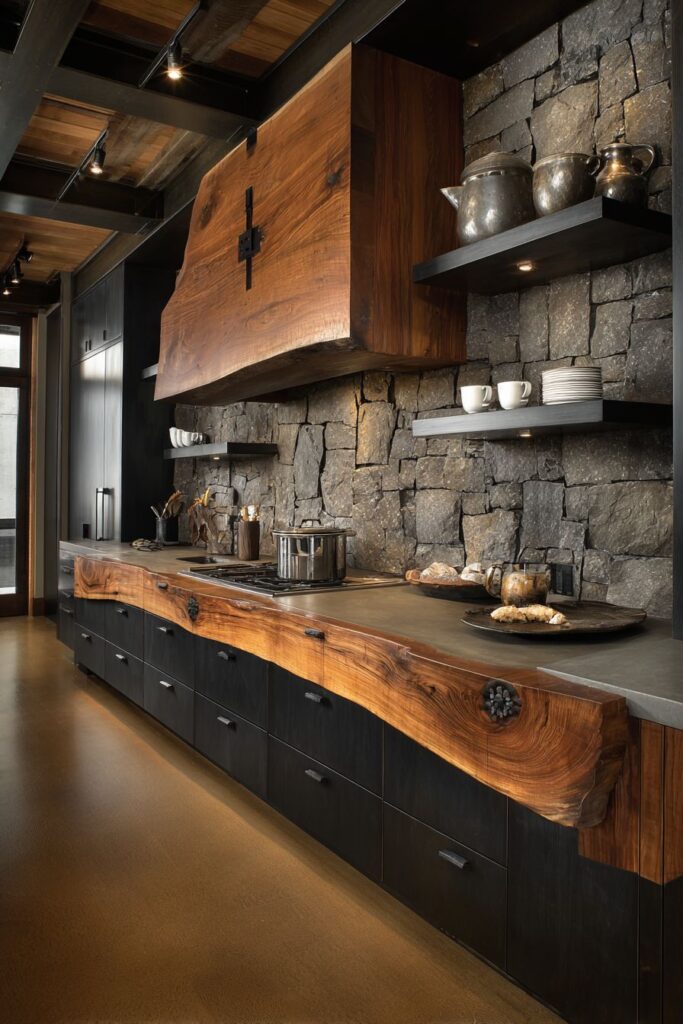
The sophisticated blend of organic and industrial elements reaches perfect balance in this live-edge walnut range hood that celebrates the natural character of solid wood while embracing contemporary steel bracket supports. This approach represents the best of both worlds – the warmth and uniqueness of natural materials combined with the precision and strength of modern engineering.
The natural wood grain tells the story of decades of growth, with each ring and variation speaking to environmental conditions and seasonal changes. Steel bracket supports provide necessary structural integrity while adding industrial character that prevents the design from feeling too rustic or traditional. The stone backsplash adds another natural texture that complements both wood and steel elements.
Mixed materials throughout the space, including concrete countertops and black steel hardware, create a sophisticated palette that feels both grounded in nature and thoroughly contemporary. This type of material mixing requires careful balance to avoid visual chaos, but when done successfully creates rich, layered environments.
Warm track lighting highlights the natural wood character while providing flexible illumination for various cooking tasks. Professional interior photography captures the sophisticated blend of organic and industrial elements that defines contemporary rustic design.
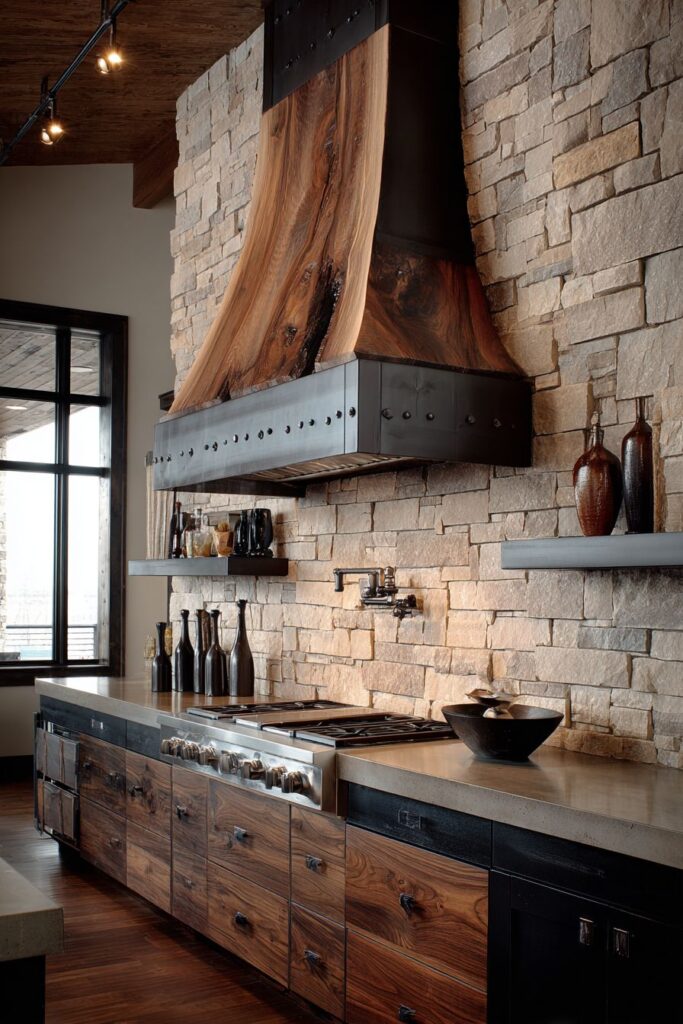
Key Design Tips:
- Select live-edge slabs with interesting grain patterns and natural character
- Balance organic materials with geometric industrial elements
- Use warm lighting to enhance natural wood colors
- Choose steel finishes that complement rather than compete with wood tones
- Incorporate other natural materials for consistency
16. Traditional English Country House Authenticity

The dignified charm of English country house design finds perfect expression in this classic brick range hood featuring an arched opening and decorative tile surround positioned above a period-appropriate AGA-style range cooker. This approach celebrates the deep traditions of British domestic architecture, where function and beauty were never considered mutually exclusive.
The handmade brick construction speaks to centuries of craftsmanship tradition, while the decorative tile surround adds color and pattern that prevents the design from feeling too austere. Dark green painted cabinets evoke the English love of deep, rich colors drawn from nature, while butcher block countertops provide the practical work surfaces essential to serious cooking.
Natural lighting from traditional leaded glass windows creates the atmospheric shadows and gentle illumination characteristic of historic English interiors. These windows, with their diamond-paned patterns and thick glazing bars, filter light in a unique way that modern windows cannot replicate, creating the romantic, softly-lit atmosphere that defines country house style.
Interior design photography emphasizes the authentic period details and traditional craftsmanship that make English country kitchens feel like they’ve been loved and lived in for generations.

Key Design Tips:
- Source authentic reclaimed bricks when possible
- Choose AGA or similar traditional cookers for authenticity
- Install leaded glass windows for period-appropriate lighting
- Use deep, rich colors drawn from the English countryside
- Incorporate copper pots and traditional kitchenware as functional decoration
17. Minimalist White Plaster Perfection
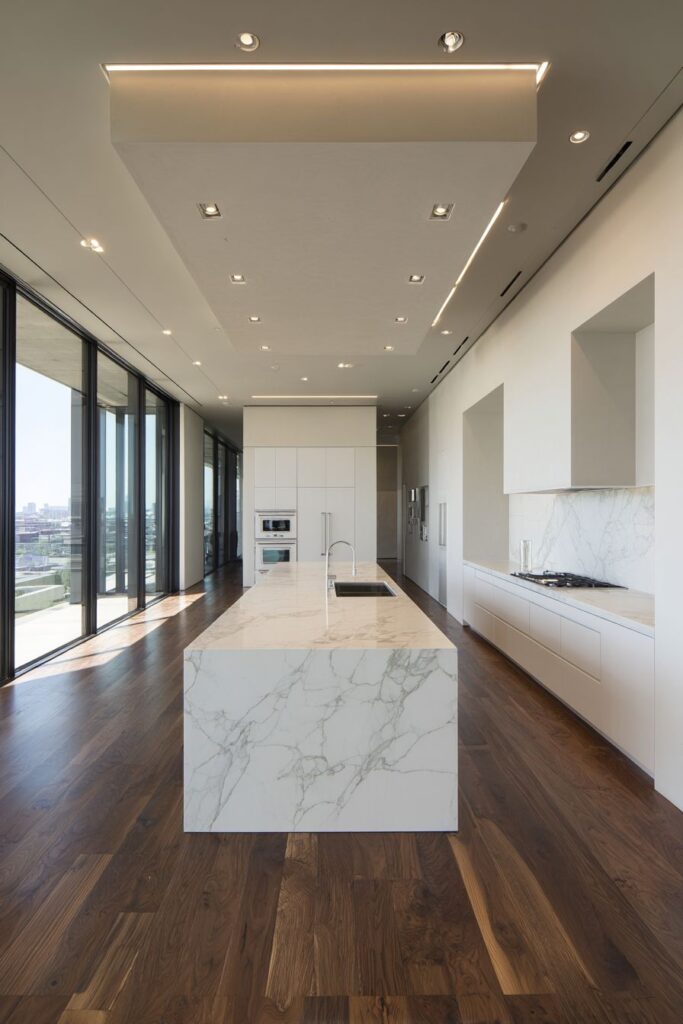
The ultimate expression of minimalist design principles manifests in this pristine white plaster range hood that achieves seamless integration with surrounding cabinetry and ceiling planes. This approach treats the entire kitchen as a single sculptural element, where individual components disappear into a unified whole that emphasizes space and light over material display.
Handle-free cabinets in matching white continue the monochromatic palette while advanced soft-close mechanisms ensure that the absence of visible hardware doesn’t compromise functionality. Quartz countertops provide durability and easy maintenance while their consistent color and pattern support the overall minimalist vision.
Concealed LED lighting provides clean illumination without visible fixtures that might interrupt the pure geometry of the design. This type of lighting requires careful planning and precise installation, but the results justify the effort by creating environments that feel almost ethereal in their simplicity.
Professional photography with balanced exposure highlights the sculptural simplicity and flawless execution that make minimalist design so compelling, demonstrating how the absence of decoration can be more powerful than its presence.
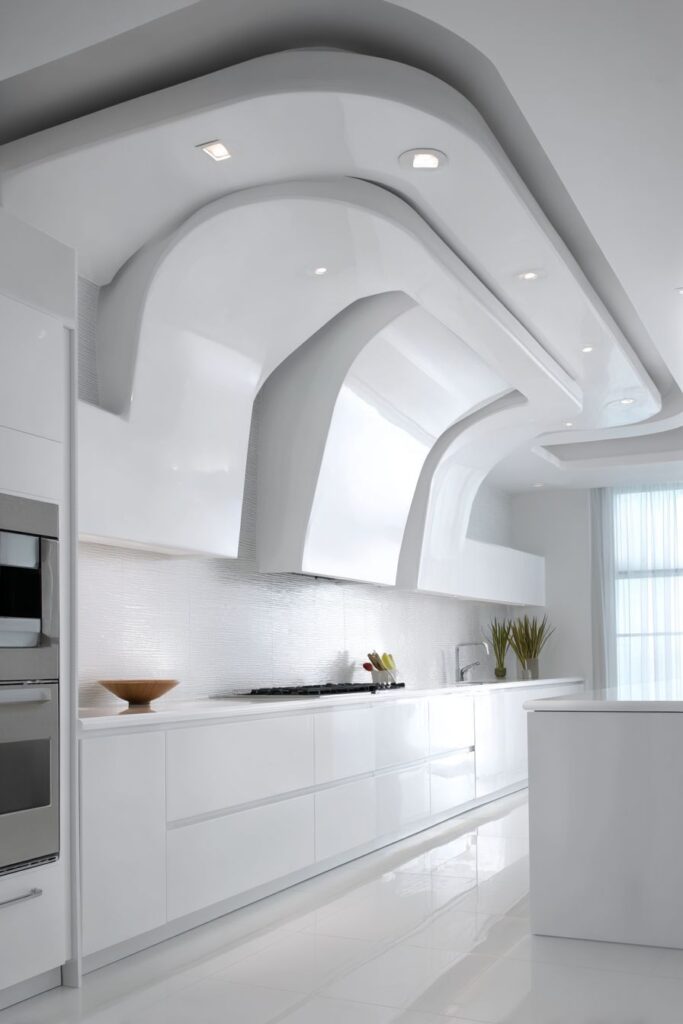
Key Design Tips:
- Plan electrical and plumbing integration during design phase
- Choose materials that accept paint finishes uniformly
- Install professional-grade ventilation systems despite invisible appearance
- Use consistent white paint throughout for seamless appearance
- Maintain clutter-free surfaces to preserve the minimalist effect
18. Industrial Loft Raw Steel Authenticity

The honest expression of urban industrial design reaches its peak in this raw steel range hood featuring exposed rivets and weathered patina suspended above reclaimed wood countertops. This approach celebrates the beauty of utilitarian materials and construction methods, treating the signs of age and use as decorative elements rather than flaws to be concealed.
Exposed brick walls and concrete floors enhance the converted warehouse aesthetic that appeals to urban dwellers who appreciate authentic materials and honest construction. These surfaces improve with age, developing character and patination that tells the story of daily use and family life. The combination creates visual and tactile richness while maintaining the tough durability essential to city living.
Edison bulb pendant lighting creates dramatic shadows that emphasize every rivet, weld mark, and surface texture that makes industrial design so visually compelling. This type of lighting transforms utilitarian elements into artistic features while providing the warm, amber illumination that prevents industrial spaces from feeling cold or unwelcoming.
Architectural photography captures the authentic urban materials and utilitarian design approach that makes industrial loft kitchens feel like extensions of the city’s creative energy.

Key Design Tips:
- Embrace authentic aging rather than artificial distressing
- Balance hard industrial surfaces with warm wood elements
- Install vintage-style Edison bulb fixtures throughout
- Choose materials that improve rather than degrade with use
- Incorporate vintage industrial accessories and found objects
19. Transitional Custom Painted Sophistication

The perfect balance between traditional and contemporary design elements finds expression in this custom painted range hood featuring raised panel details and crown molding in soft grey that complements Shaker-style cabinetry. This approach demonstrates how classical proportions and details can be updated with contemporary colors and finishes to create timeless elegance.
The marble subway tile backsplash and brass hardware add refined details that elevate the entire design while maintaining the restrained elegance essential to transitional style. These traditional materials used in fresh ways create familiarity without feeling dated, striking the perfect balance between innovation and respect for established design principles.
Natural window lighting supplemented by under-cabinet LED strips provides layered illumination that adapts to various needs throughout the day. Professional interior photography showcases the timeless elegance and careful proportions that make transitional design appealing to a wide range of homeowners.
This sophisticated approach appeals to those who appreciate both classical elegance and modern convenience, creating spaces that feel rooted in tradition while embracing contemporary lifestyle needs.

Key Design Tips:
- Choose neutral colors that complement various decorating schemes
- Balance traditional details with contemporary proportions
- Install flexible lighting systems for multiple functions
- Select hardware that bridges traditional and modern styles
- Use classic materials in fresh, updated applications
20. Asian-Inspired Zen Tranquility
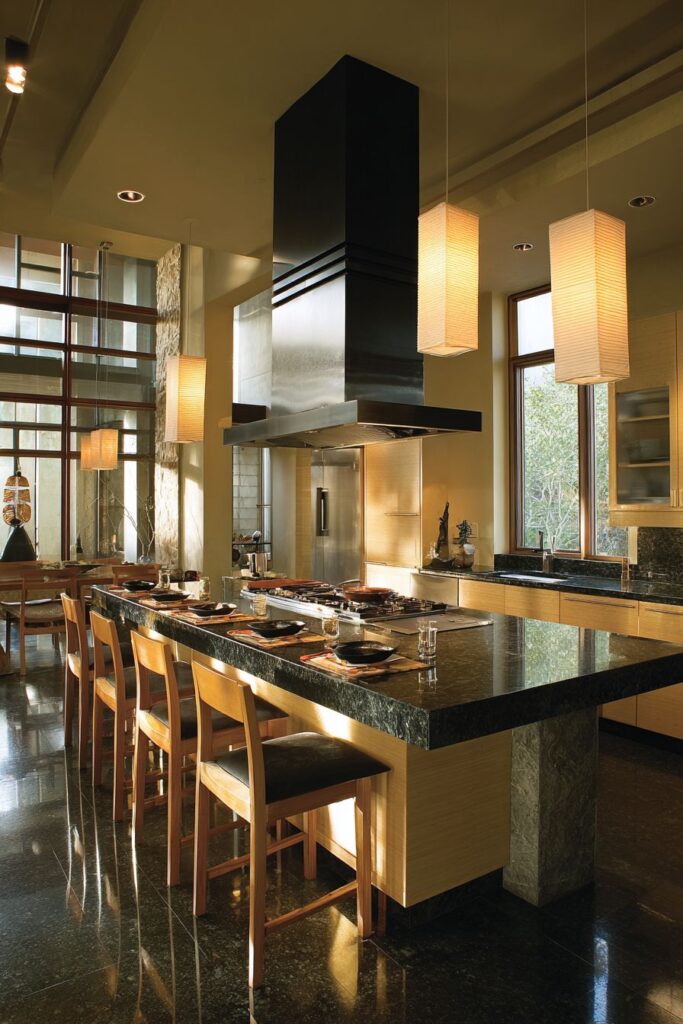
The peaceful simplicity of Asian design philosophy permeates this sleek black range hood featuring zen-like horizontal lines and a hidden ventilation system positioned above a teppanyaki cooking surface. This approach emphasizes the meditative qualities of cooking and food preparation, treating the kitchen as a space for mindful activity rather than mere utility.
Natural bamboo cabinetry and black granite countertops create serene contrast that embodies the yin-yang principle of balanced opposites. These materials were chosen not only for their visual appeal but also for their symbolic significance in Asian culture, where natural materials represent harmony with the environment and respect for traditional craftsmanship.
Soft ambient lighting from paper lantern fixtures provides gentle illumination that creates the peaceful atmosphere essential to zen-inspired spaces. This diffused light quality prevents harsh shadows while maintaining the subtle, contemplative mood that makes Asian-inspired kitchens feel like retreats from the busy world outside.
Interior design photography captures the peaceful, minimalist aesthetic and clean material palette that defines Asian-inspired kitchen design, demonstrating how simplicity can create profound beauty.
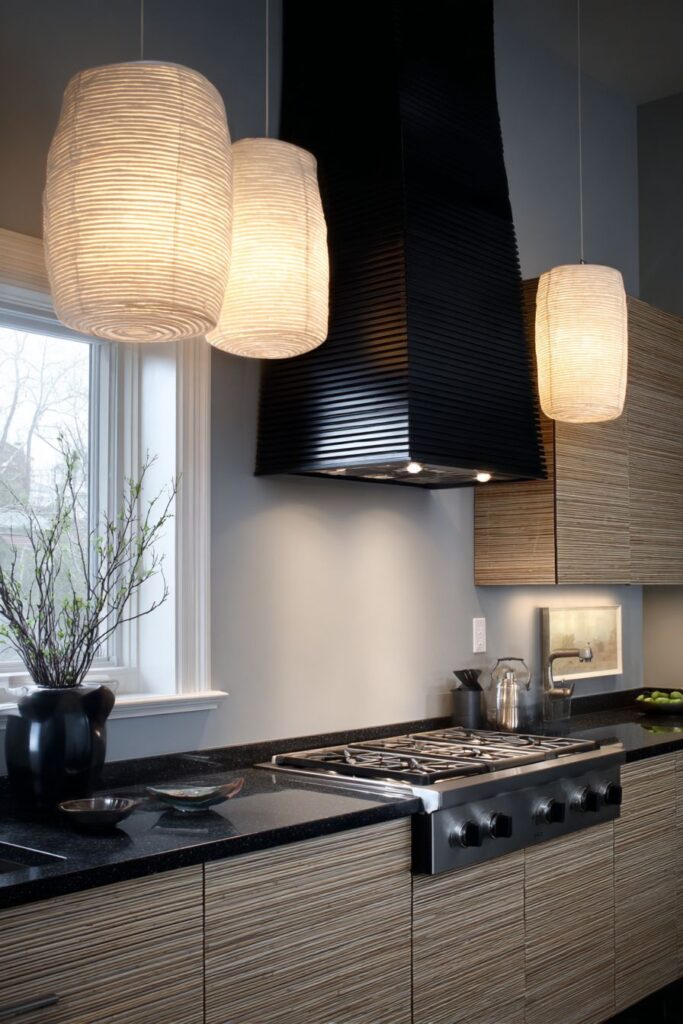
Key Design Tips:
- Choose natural materials that age gracefully over time
- Maintain clean lines and uncluttered surfaces throughout
- Install dimmable ambient lighting for flexible mood control
- Incorporate elements of water, wood, and stone for natural balance
- Use traditional Asian principles of proportion and harmony
Conclusion
The journey through these twenty distinct chimney kitchen concepts reveals the incredible versatility and transformative power of thoughtfully designed range hoods. From the sleek minimalism of contemporary stainless steel to the warm authenticity of weathered copper, each approach offers unique solutions for creating kitchens that reflect personal style while delivering exceptional functionality. The key to success lies in understanding how materials, proportions, lighting, and surrounding elements work together to create cohesive environments that enhance daily living.
Whether you’re drawn to the industrial honesty of raw steel, the timeless elegance of hand-carved stone, or the serene simplicity of Asian-inspired design, the perfect chimney hood can transform your kitchen from a simple workspace into the heart of your home. These designs demonstrate that functional elements need not be purely utilitarian – with careful planning and attention to detail, every component can contribute to the overall aesthetic vision while serving practical needs.
Take inspiration from these concepts and adapt them to your unique space, lifestyle, and personal preferences. The most successful kitchen designs combine the best elements from multiple approaches, creating personalized environments that truly reflect the people who use them. Your dream kitchen awaits – let these chimney ideas guide you toward creating a space that will inspire and delight for years to come.
